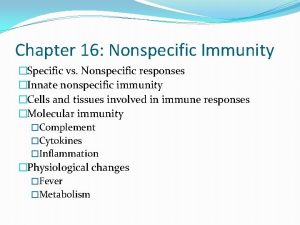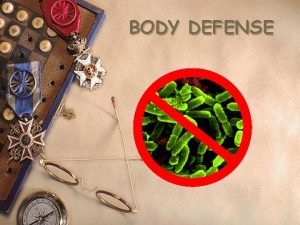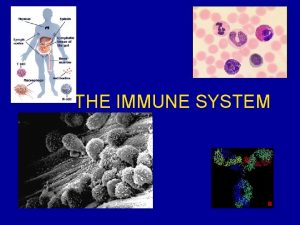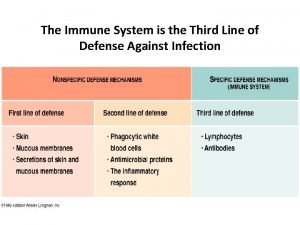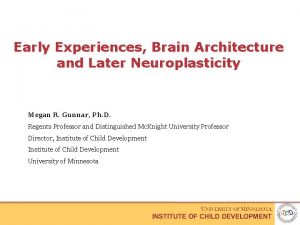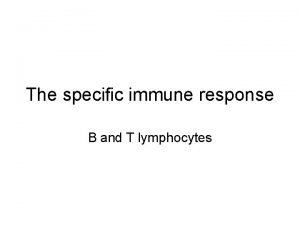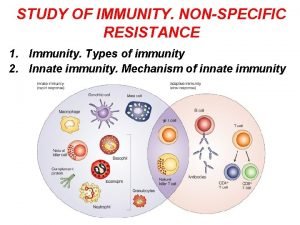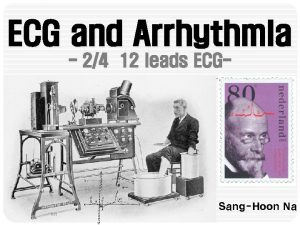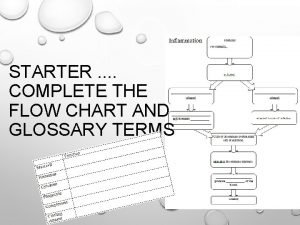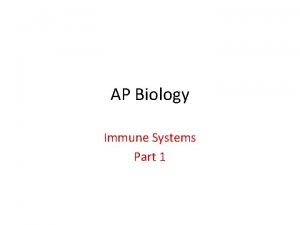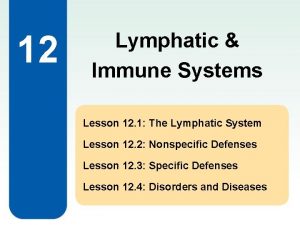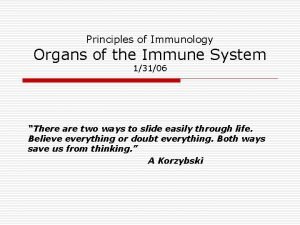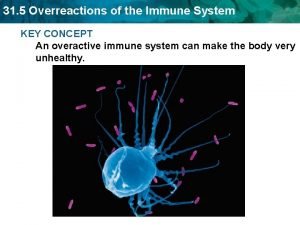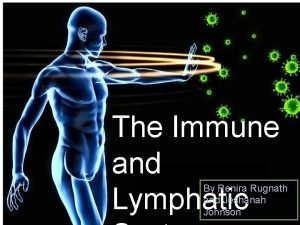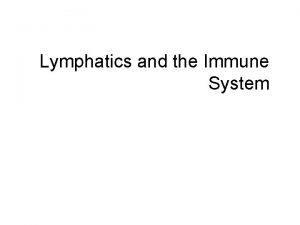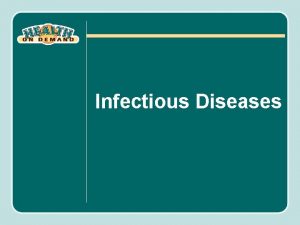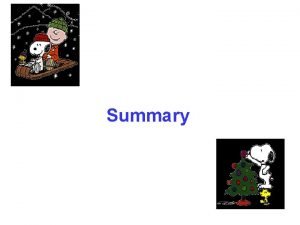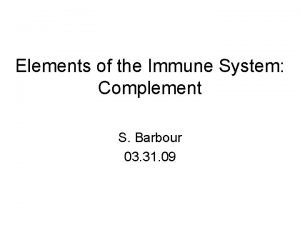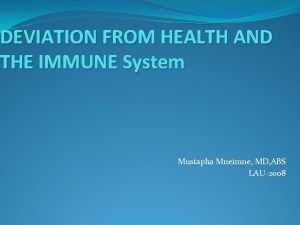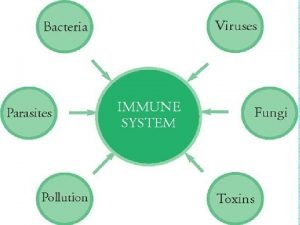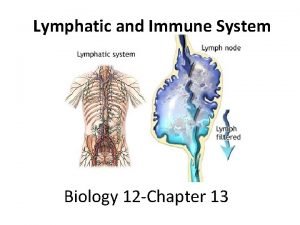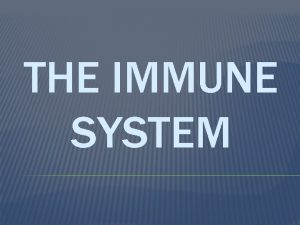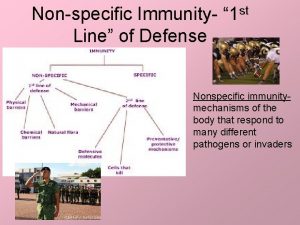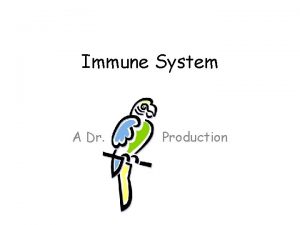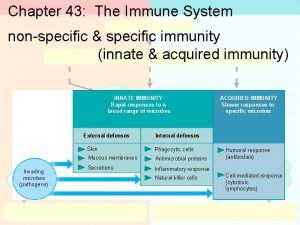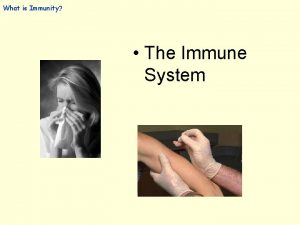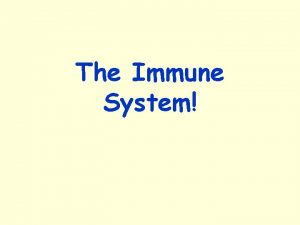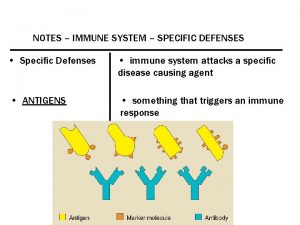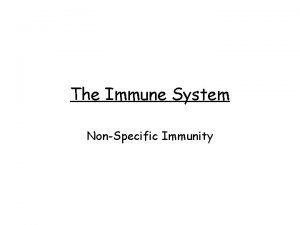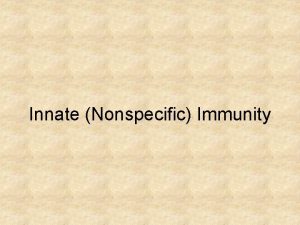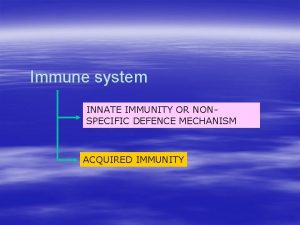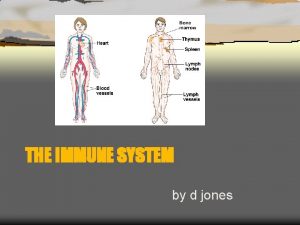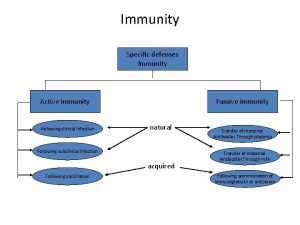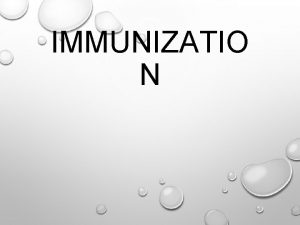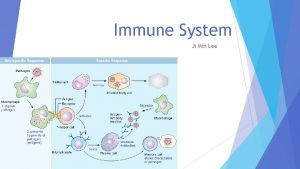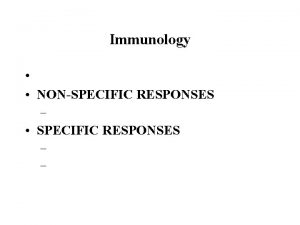Immune System Nonspecific Immunity Specific Immunity Defense system








































- Slides: 40

Immune System

Nonspecific Immunity Specific Immunity Defense system

First line of defense: Surface membrane barriers • Skin and mucous membrane – Layered epidermis and shedding of epithelial cells – Sebum inhibits growth of bacteria and fungi – Mucous traps microbes, dust and pollutants. • • • Lacrimal apparatus Saliva Vaginal secretions Flow of urine Defecation and vomiting Gastric juices destroy bacteria and their toxins

Text Table 21. 2 Oral Cavity Antimicrobial enzymes in saliva (e. g. lysozyme and lactoperoxidase) inhibit microbes, Resident flora Skin p. H (3 -5), sebum Respiratory Cavity Hairs, cilia, mucociliary escalator, Sticky mucus (lysozyme) traps dust and microbes. GI Tract low p. H and digestive enzymes, flushing action Eyes Tears, (lysozyme). flushing action Vagina p. H, flushing action, resident flora

Second line of defense: chemical and cellular defenses • Antimicrobial proteins – Interferon – Complement – Transferrins • Natural killer cells • Phagocytes – Neutrophils – Dendritic cells – Macrophages • Wandering • Fixed – Eosinophils

Interferons • Produced by lymphocytes, macrophages and fibroblasts. • Interfere with translation of viral proteins • Degrade viral RNA • Activate macrophages and NK cells • Interferon Animation

Complement Cascade Animation

Phagocytosis

Phagocyte Mobilization

Fever • Regulated my hypothalamus • Due to pyrogens secreted my leukocytes & macrophages • Causes liver and spleen to sequester zinc and iron • Increases metabolic rate (repair)

Inflammatory response Stages Inflammation Animation • Release of Chemical Alarms • Vasodilatation & Permeability of BV • Emigration of phagocytes: Dispose cellular debris & pathogens • Sets the stage for repair • Prevent spread of damaging chemicals & pathogens Signs of inflammation – – – Redness Heat Swelling Pain Impairment of function

Comparison of Immune Cells

Adaptive Resistance • Specificity—recognition of particular antigens • Memory—remembers previously encountered antigens • Systemic—immunity is not restricted to the initial infection site • Immune responses – Antibody-mediated or humoral immune responses (late 1800 s) – Cell-mediated immune responses (mid 1900 s)

T Lymphocytes • CD 4 T cell - also known as a T Helper (Th) cell • CD 8 T cell - also known as a Cytotoxic T (Tc) cell


Antigens and antigen receptors • Antigens can be entire microbes, parts of microbes or chemical components of pollen, egg white, blood cells, …….

Self antigens: MHC proteins • Antigens on our own cells are self-antigens • MHC proteins are glycoproteins that mark the cell as self. – Class I MHC proteins are on all body cells. Receptors on TC – Class II MHC proteins are only on certain cells that act in the immune response. Receptors on TH – Antigen Processing

Immunocompetence • T and B cells that have not been exposed to an antigen are naïve. • Binding with an antigen completes differentiation into functional B and T cells. • B cells mature in the bone marrow. • T cells mature in the thymus.

Antigen receptors • Genes determine what foreign substance will be recognized. • An antigen determines which T or B cells will be activated. • Lymphocytes make over a billion different receptors. • Gene segments of a few hundred bits are reshuffled and combined--somatic recombination. • The newly assembled gene is expressed as a receptor on the cell surface.

Humoral immune response • Antigen challenge—the meeting between a naïve immunocompetent lymphocyte and an invading antigen. • Occurs in lymphoid tissue such as spleen or lymph node. • If antigen challenge is presented to a B cell then the humoral immune response is provoked.

Clonal Selection Monoclonal Antibody Production

Antibodies “immunoglobulins”

Immunoglobulin classes • Ig. D is attached to B-cell plasma membrane • Ig. M is released during primary response. Indicates current infection. • Ig. G is the most aboundant. Can cross placenta & blood vessel walls. • Ig. A found in body secretions prevents attachment to body surfaces. • Ig. E causes release of histamine (allergies) by attaching to mast cells & basophils.

Immunological memory • Primary immune response • Secondary immune response


Antibody defense: PLANe • Precipitation • Lysis: Complement fixation and activation • Agglutination • Neutralization • Enhancing phagocytosis


Cell-mediated immunity • Antibodies can only inactivate an antigen and NOT destroy it. • Antibodies prepare an organism for destruction by innate defenses. • T cells can only recognize and respond to processed fragments of protein. • T cells are suited for cell to cell interaction and target body cells infected by virus, bacteria and abnormal or cancerous body cells or cells that are transplanted or infused.

Cell-mediated immunity: T-cells • Activation of T cells—T cell receptors bind to antigen presented by the antigen-MHC complex. • CD 4 and CD 8 proteins interact with antigen and help maintain MHC-antigen coupling. • Types of T-cells – Helper T cells (CD 4) – Cytotoxic T cells (CD 8) – Memory T-cells


Activated T cell • Activation leads to enlargement, differentiation and proliferation of T cells. • T cells that are reproduced are clones of originally activated T cell. • Activation, differentiation and proliferation occurs in secondary lymph organs and tissue. • Activation leads to release of inflammatory cytokines.

Homeostatic imbalances : Immunodeficiencies • Abnormally behaving immune cells • Severe combined immunodeficiency (SCID) syndromes – Congenital conditions • Acquired immune deficiency syndromes – Hodgkin’s Disease – HIV – AIDS

Homeostatic imbalances : Autoimmune disease – Tend to be more prevalent in women • Type I diabetes—destroys pancreatic beta cells • Multiple sclerosis—destroys myelin sheaths • Myasthenia gravis—impairs communication between nerve and muscle • Lupus erythematosus—systemic disease of skin, kidneys, heart, and lungs • Rheumatoid arthritis—destruction of joints

Organ transplants • Autografts—grafts from the same person to another body site • Isografts—grafts between genetically identical individuals • Allografts—grafts among the same species • Xenografts—grafts taken from another animal species

Hypersensitivities Hypersensitivity Reactions in the Skin

Hypersensitivities Acute Immediate Subacute cytotoxic Subacute Immune complex Delayed

Type I Hypersensitivity Animation Type II Hypersensitivity

Type III Hypersensitivity

Animations • Flash animation of a NK cell interacting with a normal body cell. • Flash animation of a NK cell interacting with a virus-infected cell or tumor cell not expressing MHC-I molecules. • Flash animation of apoptosis by NK cells. • HIV Replication

Resources • Components of the Immune System Animation
 Th and tc cells
Th and tc cells Nonspecific vs specific immunity
Nonspecific vs specific immunity Specific vs nonspecific defense
Specific vs nonspecific defense схема імунної відповіді
схема імунної відповіді Nonspecific host defense mechanism
Nonspecific host defense mechanism Primary immune response and secondary immune response
Primary immune response and secondary immune response What is the third line of defense in the immune system
What is the third line of defense in the immune system Third line of defense immune system
Third line of defense immune system Second line of defense immune system
Second line of defense immune system 1st 2nd and 3rd line of defense immune system
1st 2nd and 3rd line of defense immune system Immune system lines of defense
Immune system lines of defense Difference between acquired immunity and innate immunity
Difference between acquired immunity and innate immunity Innate immunity first line of defense
Innate immunity first line of defense Innate immunity first line of defense
Innate immunity first line of defense Innate immunity first line of defense
Innate immunity first line of defense Ciliary escalator
Ciliary escalator 3 lines of defense immunity
3 lines of defense immunity Non specific immunity
Non specific immunity Neutrophil extracellular traps
Neutrophil extracellular traps Hampton hump xray
Hampton hump xray T wave height
T wave height Flow chart
Flow chart Chapter 35 immune system and disease
Chapter 35 immune system and disease Ap bio immune system
Ap bio immune system Lesson 12.1 lymphatic ducts and vessels
Lesson 12.1 lymphatic ducts and vessels Lesson 12 blood and immune system
Lesson 12 blood and immune system Oobean
Oobean Immune system definition
Immune system definition Overreactions of the immune system
Overreactions of the immune system Lymphatic vs immune system
Lymphatic vs immune system Phagocitize
Phagocitize Defination of infection
Defination of infection What is the main function of the immune system
What is the main function of the immune system Malt
Malt Thymus immune system
Thymus immune system Mac immune system
Mac immune system Thalassemia facies
Thalassemia facies 1what's the purpose of the body's immune system?
1what's the purpose of the body's immune system? Specific gravity formula
Specific gravity formula Specific gravity pharmacy
Specific gravity pharmacy Chapter 13 lymphatic system and immunity
Chapter 13 lymphatic system and immunity

